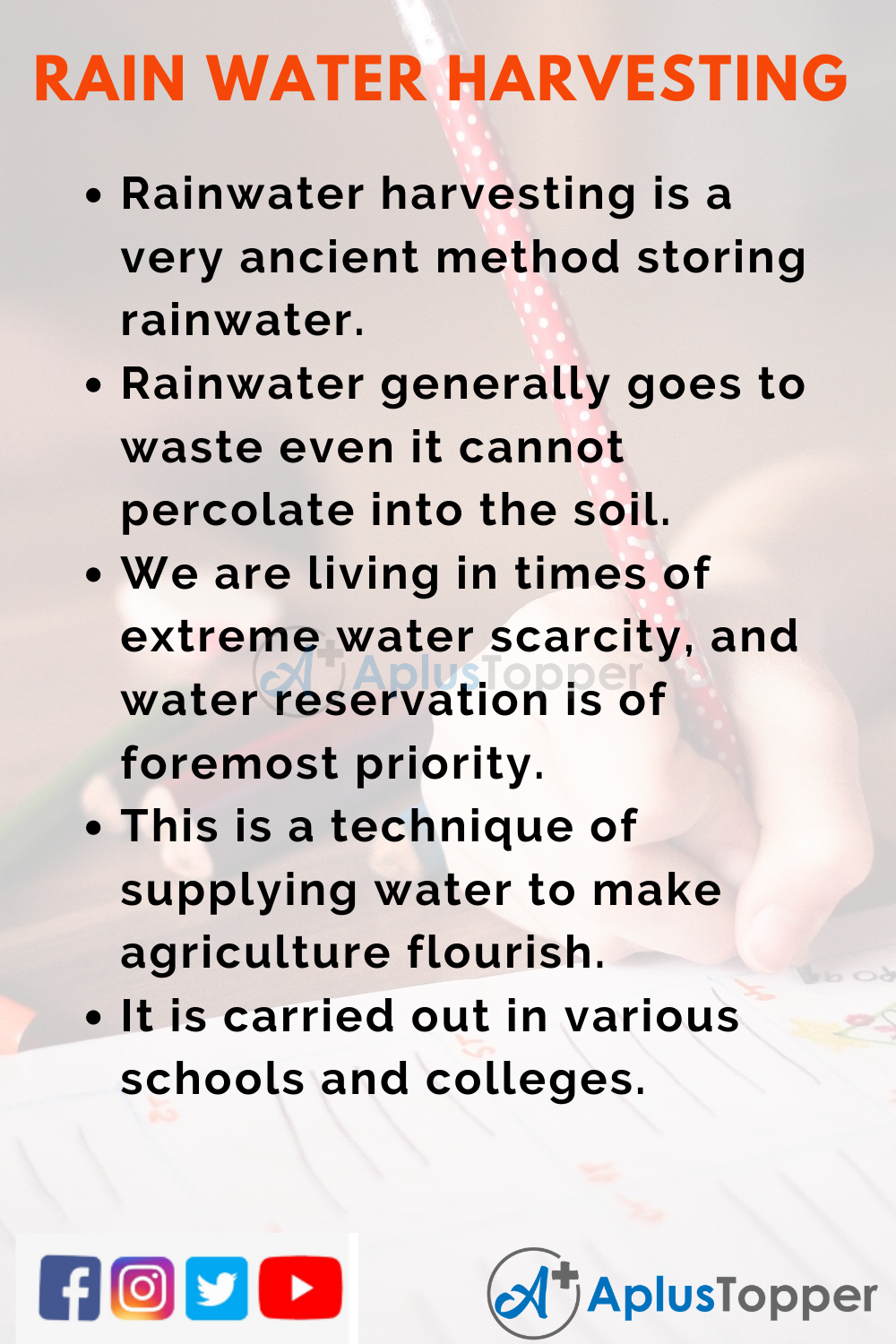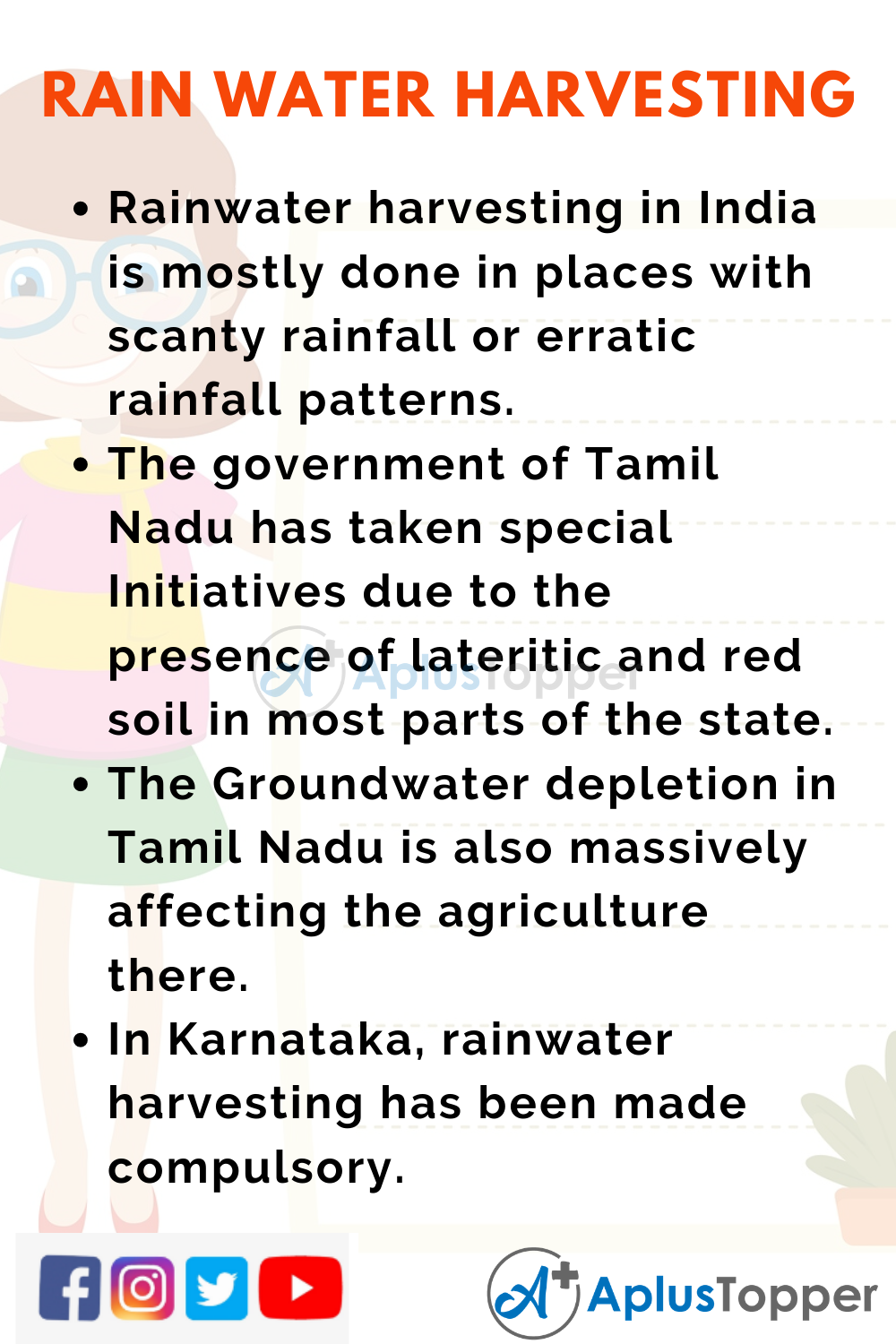10 Lines on Rainwater Harvesting: Rainwater harvesting is the process of storing and collecting the rain that we get due to precipitation for future use. This water is stored in a tank, a cistern, or even a pit. The water can either be taken out of the system using a pump, or it can be hand-drawn in case of a shaft. The pit is generally in the form of a well or a deep shaft. It is helpful in the places where irrigation is necessary to grow crops, and rainfall is scanty. It can also be used for the household purpose of cleaning and cooking. Most of the time rainwater is very safe to use directly. But it is very much recommended to boil or filter water before consuming it.
You can read more 10 Lines about articles, events, people, sports, technology many more.
Set 1 – 10 Lines on Rainwater Harvesting for Kids
Set 1 is helpful for students of Classes 1, 2, 3, 4 and 5.
- Rainwater harvesting is a very ancient method storing rainwater.
- Rainwater generally goes to waste even it cannot percolate into the soil.
- We are living in times of extreme water scarcity, and water reservation is of foremost priority.
- This is a technique of supplying water to make agriculture flourish.
- It is carried out in various schools and colleges.
- The first site for rainwater harvesting came in the year 2500 BC
- It was a large cistern.
- The cistern was discovered in Jerusalem.
- The construction of such pits can be traced back in history.
- There are small and large systems of Rainwater Harvesting.

Set 2 – 10 Lines on Rainwater Harvesting for School Students
Set 2 is helpful for students of Classes 6, 7 and 8.
- The first tank for harvesting was found in the biblical city of Ai.
- It was made of stable rock structures and stones.
- This method of rainwater harvesting prevented the accumulation of water in the soil.
- So much water in the soil can lead to seepage and swamps.
- The Greeks were the first to introduce the use of shafts to store water.
- They propagated various methods of storing water.
- The process of storing rainwater in vast quantities begun in the city of Crete, and four large cisterns were created for that purpose.
- In India, Rainwater Harvesting was begun by the rulers of the Chola Dynasty.
- The Shiva Ganga Tank was one of the first tanks in the country to store water from rainfall.
- The later part of the Chola rule witnessed the tanks being built in various parts of North India and some Cuddalore districts.
Set 3 – 10 Lines on Rainwater Harvesting for Higher Class Students
Set 3 is helpful for students of Classes 9, 10, 11, 12 and Competitive Exams.
- Rainwater harvesting in India is mostly done in places with scanty rainfall or erratic rainfall patterns.
- The government of Tamil Nadu has taken special Initiatives due to the presence of lateritic and red soil in most parts of the state.
- The Groundwater depletion in Tamil Nadu is also massively affecting the agriculture there.
- Due to the significant effort put in by the government of Tamil Nau, Chennai saw massive growth in water level, and the quality of water improved.
- In Karnataka, rainwater harvesting has been made compulsory.
- With the joint attempts of the government and the Indian Institute of Science, Bangalore has improved the rainwater harvesting techniques substantially.
- Awareness has been generated in most parts of the country regarding the necessity of harvesting.
- In Rajasthan, too, the attempts for harvesting rainwater have seen significant improvement.
- Maharashtra has black soil and the irrigation facilities there are less.
- Over there, rainwater is harvested extensively in Maharashtra because of floods.

FAQ’s on 10 Lines on Rainwater Harvesting
Question 1.
What are some of the new methods of rainwater harvesting?
Answer:
The method of Roof hatchments and Groaisis boxes are being used in several countries now.
Question 2.
Why does the Indian soil need rainwater harvesting?
Answer:
The rainfall patterns in India are pretty erratic; storing water in the form of rain is a necessity.
Question 3.
What is the reason behind rainwater harvesting?
Answer:
Rainwater harvesting is the method of storing rainwater. Water from rainfall is stored in dams, wells, and shafts. This stored water is later on used for the purposes of irrigation in an area where rainfall is uncertain. It is also used by the household for purposes of cooking and other household activities. Many states and countries all over the world have made it compulsory to store rainwater. It helps in reducing the wastage of water. Water scarcity is a massive and not so trivial problem.
Question 4.
What chemicals can be found in the rainwater?
Answer:
Sodium, magnesium, potassium bicarbonate etc. can be found in the rainwater.
